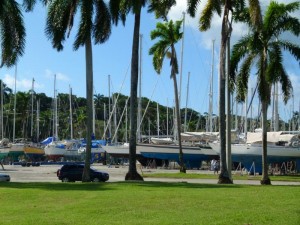1 February
Left Bocas Marina around 1330 and headed for the San Blas islands, to cruise around for a couple of weeks before heading back to Colon and Shelter Bay Marina, where we’ll make final preparations to transit the Canal and head to the Galápagos.
Trip to Bocas was motoring and motor sailing, pretty bouncy and lumpy and wet, especially as we passed a few miles offshore from Colon. Ugly trip, pretty uncomfortable. Water was flying around, hatches leaked, impossible to sleep up in the forward cabin (where my bunk is) – too much pitching and slamming and getting tossed in the air. The boat motion was very solid and strong – this is a no-nonsense vessel.
Got to Porvenir in about 26 or 27 hours, just as expected. Checked in, then went to the nearby Lemon Cays to anchor for a couple of days.
4 February
Moved from the Lemon Cays over to Salardup, about 12 miles farther east. All well.
14 February
Moved from the San Blas islands to Portobelo, about an 8-hour trip – good sail, reaching in 15-20 knots of wind. Even with the old sails, we were running at 8 or 9 knots at times and 7 knots when the wind dropped off a little.
Didn’t do much in the San Blas – pretty much just hang out, do a little sailing in the dinghy, swim and snorkel a bit, work on the boat a little bit.
Sorry to say it, but in addition to the $200 cruising permit each boat is required to get and the $100-per-cruiser “mariner’s fee” the Panamanian government also extracts (I was exempt because I entered the country by airplane), the Kuna people now require papers, permits, and fees. Lots of fees. I understand that the San Blas are the Kuna’s territory (technically, it’s Kuna Yala, an autonomous territory that is not part of Panama), still, it seems only fair that the “authorities” of a given area actually do something or provide some service in exchange for the fees they extract.
Some other cruiser can check me on the facts, but I believe that Panama has now become one of the more expensive cruising grounds in the world.
15 February
Today we moved from Portobelo to Shelter Bay Marina, just two or three hours farther down the coast, and were all tied up by mid afternoon. While in the marina we’ll deal with some final repairs and equipment upgrades and take care of final provisioning. We won’t stop in Balboa, at the other end of the Canal – the plan is to keep on going, zarpe in hand for the Marquesas but make an intermediate stop in the Galápagos islands.
21 February
Yow – didn’t realize it had been so long since I last posted. We’re in Shelter Bay Marina, near the city of Colón at the north entrance to the Panama Canal. We got here a week ago and have made good use of the time:
-
Got the new mainsail and the new mizzen installed, along with their lazy jacks and built-in sail covers. The covers had to be modified somewhat, which in turn required scaring up a heavy-duty sewing machine. That happened, and Meagan, one of the Silver Lynx crew, did a masterful job of making the needed mods.
-
Got the old battery banks removed and new batteries installed. Sounds simple enough, but lifting twelve cells, each of which weighs 42 kilos (93 lbs), out of a battery box below the cabin sole, moving each cell up to the cockpit, over the coaming, and down onto the dock gets old in a big hurry. Then the new batteries (which were slightly lighter than the old ones, a mere 35 kilos each) all have to get onto the boat and into their proper places, of course.
We had to make up some new battery cables, but Matt bought a lot of new 3/0 cable and a bunch of lugs, and had a hydraulic crimper on board. And we were able to borrow a ratcheting cable cutter from the electrician over in the boatyard. Having the right tools and a couple of electricity-savvy installers (Matt and Ryan) made the installation of the new batteries (Trojan T-145s) go pretty quickly and straightforwardly.
-
Got the emergency Honda 2000 genset running fine (carburetor very dirty).
-
Got some frozen bolts out of the little 2-horse outboard motor, so it’s ready to be put back into service.
-
Made two big provisioning runs into Colón, for assorted houseware stuff like Tupperware-style plastic storage bins. And for mass quantities of groceries. And beer and tequila and rum. Hey, man cannot live on bread alone.
Just got word that we’re scheduled to begin our transit in a week, on 28 Feb, which is exactly the date Matt wanted. Good. I’m ready to be back in the Pacific and moving on.







